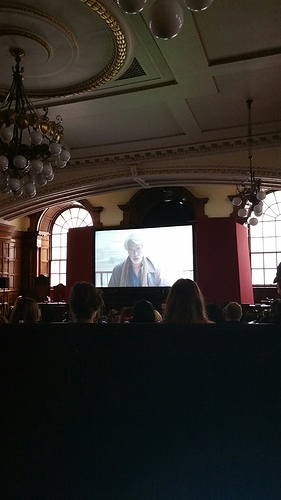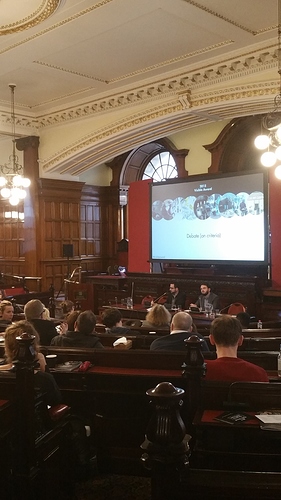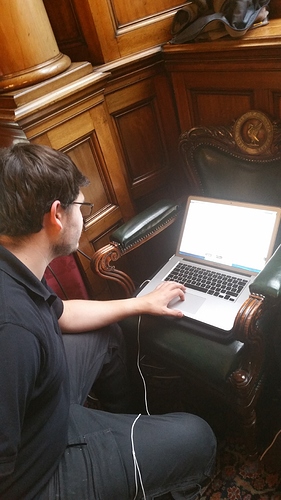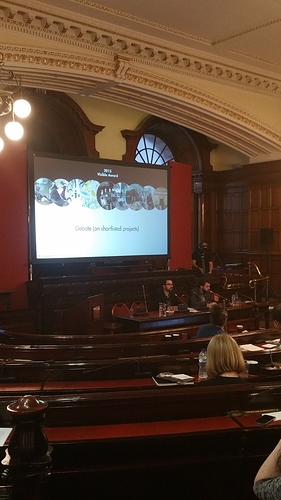Please join e-flux conversations for coverage of the Visible Award temporary parliament by writer Emma Sumner, live from Liverpool on Saturday, October 31st from 12pm-6pm GMT. A live stream of the event is available on the Visible Award site here.
The Visible Award is the first European award for socially engaged artistic practices in a global context. First awarded in 2011, and then again in 2013, 2015 will be the first time the award is decided through an open jury consultation in the form of a temporary parliament. A public jury format was trialled for the 2013 Award at the Van Abbemuseum in Eindhoven, and has been further developed to seek public engagement with the assessment of existing artistic projects that are operating at the crossroads of art and other fields of society.
The jury session will take place in the grand Council Chamber of Liverpool Town Hall, and will bring together artists, experts, and users of socially engaged artistic practices in a one-day conversation that will try to merge the procedures and criteria of an evaluation process with the discursive elements that characterise panel discussions on the relationship between arts and society. The event, free and open to the public, will focus on assessing the merits of the shortlisted artistic projects (all currently operational) and on the selection of the winner of the 2015 Visible Award, through an open vote.
The 2015 Visible Award has been developed in collaboration with Chris Dercon, Director, Tate Modern, and will be chaired by Francesco Manacorda, Artistic Director, Tate Liverpool, who will coordinate the debate, together with Andrea Phillips in the role of advocate for the projects, between a group of experts operating in different fields of culture, brought together to assess the merits of the artistic projects and lead the selection of the winner of the 2015 Visible Award.
The projects that will be publicly debated by the jury have been shortlisted from a long list of 67 projects, selected from a list of 58 art projects nominated by the 2015 Visible advisory board and 98 projects received through open call.
The nine shortlisted projects are: Abounaddara by Abounaddara Collective (Syria), Conflict Kitchen by Dawn Weleski and Jon Rubin (USA), Cinema Everywhere by Waguih El laqany (Egypt), Ecoart Uganda by Ruganzu Bruno Tusingwire (Uganda), Movimento Editorial by Cráter Invertido (Mexico), New World Summit by Jonas Staal (The Netherlands), Salt by Karrabing Film Collective (Australia), Mujawara / The Tree School by Campus in Camps and Contrafilé (Palestine-Brasil), White Paper: The Law / Convention On the Use of Space by Adelita Husni Bey (The Netherlands).
From Monday 26 October, for the week leading up to the public jury session, Tate Liverpool will host a free temporary exhibition of these nine shortlisted projects, each represented by a video in the museum’s public foyer.
The jury session — live streamed on 31 October at the Visible website (www.visibleproject.org) and to audiences in Tate Liverpool’s foyer and open to interaction through social media — is not simply a dialogue between experts, in order to select an exemplary socially engaged art project, but also a moment for sharing knowledge and collective learning. In the process of assessing the winning project the jury will also offer an opportunity to deepen the debate around artistic engagement in the public domain.
Projects shortlisted for the 2015 Visible Award have been publicly announced on 11 August 2015 during the evening event, The Night Art Made the Future Visible, part of the Creative Time Summit: The Curriculum, within the 56th International Art Exhibition of la Biennale di Venezia: All the World’s Futures. The winning project will be awarded in New York City on the 13th of November 2015 on the occasion of the second installment of The Night Art Made the Future Visible at the Creative Time Summit in New York.
The invited experts part of the Temporary Parliament are Anna Colin, Ekaterina Degot, Magdalena Malm, Emily Pethick, Laura Raicovich, Nato Thompson (tbc), Charles Esche, Christine Eyene (tbc), Simon Sheikh (tbc), Beatrice Catanzaro, Marinella Senatore, Jason Bowman, Bill and Wendy Harpe (Black-E), Britt Jurgensen, Assemble, Granby Community Land Trust, Nina Edge, Janna Graham, Sophie Hope.
Additional material:
- Here’s a link to the Visible Award booklet to be handed out at the parliament.
- Video statements from the nine shortlisted artists.
- Click here to download the Visible Award dossier.
Schedule of the day
11.00 - 12.00 - Registration and brunch
12:00 - 12.15 - Welcome by Francesco Manacorda and Chris Dercon (via video)
12:15 - 12:30 - Introduction to the jury by Matteo Lucchetti and Judith Wielander
12:30 - 13:30 - Presentations of the 9 shortlisted projects and videos, with Andrea Phillips
13:30 - 14:30 - First round of debate (among criteria)
14:30 - 14:45 - coffee break
14:45 - 17:30 - Second round of debate
17:30 - 17:45 - Voting (coffee break)
17:45 – Announcement of the winner of 2015 Visible Award
17:45 - 17:50 - Skype with the winner
17:50 - 18:00 - Closing remarks







